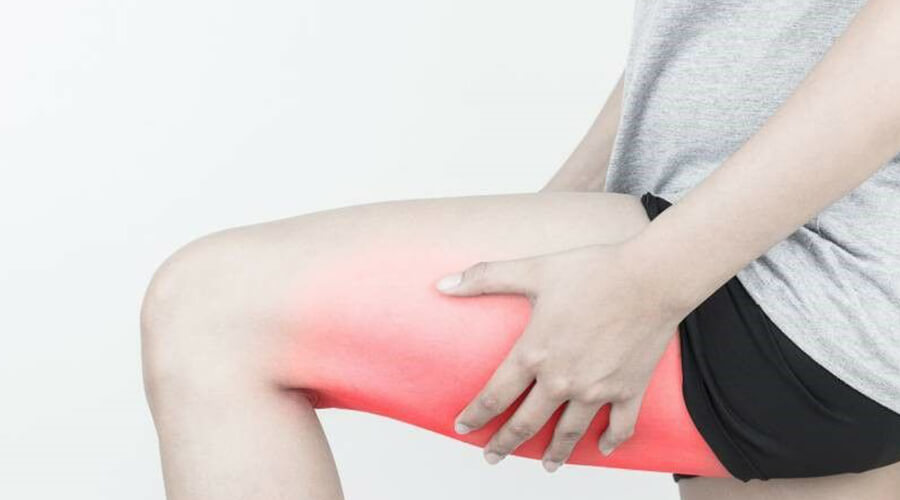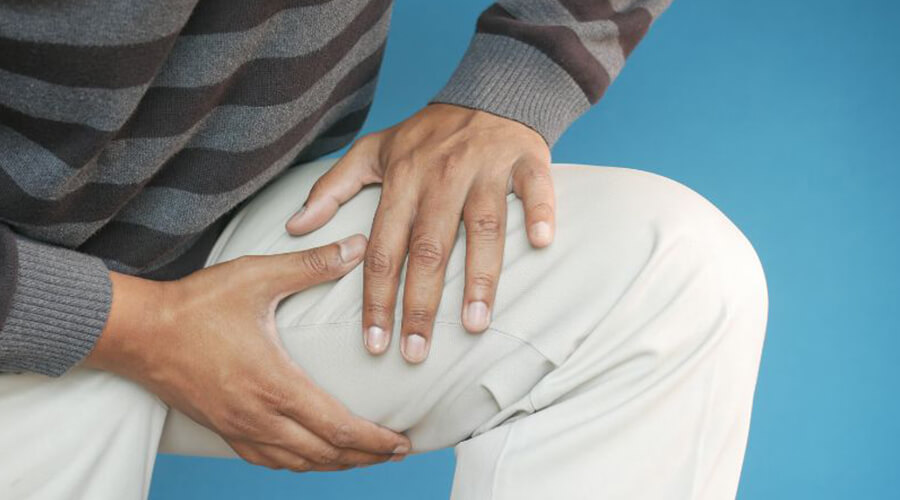
Many people can develop meralgia, or thigh pain. This is also a tunnel syndrome that develops in the lower limb and is a very common condition.
The idea is to put pressure on the cutaneous nerve supplying the outer part of the thigh. Damage to or impairment of the purely sensory nerve does not affect the muscle function of the limb.
The symptoms are:
– You may experience numbness, numbness and burning pain in the outer thigh area.
– This is usually a unilateral complaint.
– The pain increases after prolonged standing or walking.
– The pain may increase at night with the leg stretched out.
– There may be a dull aching pain in the buttocks, most often felt when climbing stairs.
There are some reasons why thigh pain can develop more easily. It can be caused by a tight dressing, but it can also occur after an accident, in the case of a herniated disc, during abdominal surgery, or even from prolonged standing.
There are also risk factors such as being overweight. Being overweight increases the pressure on the nerves. Increased pressure also occurs during pregnancy. Diabetes can also be a risk factor and of course age. People between 30 and 60 can be affected.
Possible therapies include removing the pressure on the nerve, wearing looser clothing and reducing your weight if you are overweight. You may also experience thigh pain and upper thigh pain after pregnancy. After childbirth, the symptoms usually disappear.
Thigh pain
The thigh pain causes may depend on several things. It is more common in women. Reasons include pain associated with menstruation and pregnancy. Whether it is left thigh pain or right thigh pain, it can be caused by inflammation after surgery or by external physical impact. In such cases, ultrasound may be necessary to identify and treat the problem.
Femur pain
Thigh flexor pain is most often caused by an external injury (sports injury) or joint or other muscle problems. If we can’t pinpoint the cause of the pain, it is recommended that you have it checked out!
Thigh pain when sitting
Thigh pain when sitting can be caused by a number of reasons. One of the most common causes is piriformis syndrome, which occurs when the piriformis muscle is swollen, strained or pressing on the spinal cord. Other possible causes include abnormalities of the muscles, joints or bones, but also osteoporosis, poor posture, sedentary work, muscle weakness and general health.
Thigh pain and numbness
Thigh pain and numbness can occur for a number of reasons, such as neurological problems, a herniated disc, sciatica, the femoral nerve and others. Other causes may include venous thrombosis, arterial blockage, muscle inflammation, and joint and bone abnormalities. Therefore, if the complaints are persistent and do not stop, it is worth consulting a doctor.
Pain in the back of the thigh, or back thigh pain, can be caused by a number of different things.
Muscle strain: The muscles in the back of the thigh, such as the hamstrings, can be easily strained or overstretched, for example as a result of intense exercise, overloading or sudden movements. This can lead to muscle pain in the back of the thigh.
Muscle injuries: muscle injuries such as muscle tears or strains can also cause pain in the back of the thigh.
Nerve-related pain: nerves running along the back of the thigh, such as the sciatic nerve, can be damaged or pinched, causing pain in the back of the thigh.
Hip joint problems: pain in the back of the thigh can also be caused by hip joint problems, such as arthritis, injury or wear and tear of the joint tissue.
Spinal problems: lower back pain, such as in the waist, can also lead to pain in the back of the thigh, for example due to scoliosis or hernia.
Thigh neuropathy
Femoral neuritis is most often caused by a bump, hernia or degenerative disease between the vertebrae in the lumbar spine. In addition, osteoporosis, musculoskeletal disorders and pregnancy can also cause thigh neuritis. Symptoms can include pain, tenderness, tingling, weakness in the thigh and leg, and limited mobility.
Night thigh pain
Night thigh pain is a condition in which thigh pain occurs at night or during sleep. It can be an unpleasant and disturbing symptom that can be due to a variety of causes. There are different forms, causes and treatment options for night thigh pain.
Musculoskeletal causes:
thigh pain at night is often linked to muscle and bone problems. Muscle spasms, muscle strains or muscle spasms can occur at night as the muscles relax during sleep and this can cause thigh pain. Wear, inflammation or injury to joints such as the hip joint or knee joint can also cause thigh pain at night.
Treatment: the treatment of musculoskeletal causes depends on the underlying problem. Stretching, massage or hot baths can be used to relieve muscle spasms. For joint problems, treatment may include physiotherapy, medication (e.g. painkillers or anti-inflammatories), injections or even surgery if necessary.
Neurological causes:
certain neurological conditions can also lead to thigh pain at night. For example, nerve inflammation, such as sciatic neuralgia (inflammation of the sciatic nerve), or nocturnal leg movement syndrome (RLS) can also cause pain in the thigh at night.
Treatment: treatment of basic neurological problems depends on the diagnosis. Medications, physiotherapy or other therapeutic options may be used, depending on the cause.
Circulatory causes:
circulatory problems, such as arterial stenosis or thrombosis, can also be behind thigh pain at night. Such conditions often cause pain at night, as blood circulation can slow down during sleep and this can exacerbate symptoms.
Treatment: treatment of basic circulatory problems depends on the diagnosis. Lifestyle changes, medications or surgery may be necessary for vasoconstriction.
Musculoskeletal problems:
thigh pain at night can be caused by musculoskeletal problems such as fibromyalgia or arthritis. These conditions often cause pain in the thigh at night as the affected tissues are strained by postures during sleep.
Treatment: the treatment of basic musculoskeletal problems depends on the disease. Prescribed medication, physiotherapy, lifestyle modifications or other alternative therapies may be used.

Treatment of thigh pain
Treatment of thigh pain depends on the cause. To relive the pain in thigh muscles there are a number of treatment options available, such as: painkilling medication, physiotherapy, muscle relaxation exercises, massage, and in the case of spinal conditions, surgical treatment may be necessary. To choose the right treatment, a medical examination is necessary to identify the cause and to apply the appropriate treatment.
Medication for pain relief is often recommended, but it is also worth trying herbal balms as natural pain relief can also be effective. If conservative treatment is not successful and symptoms are long-standing, surgery may be an option. The condition should also be distinguished from spinal neuritis and hip and pelvic processes as the symptoms are similar. For very persistent numbness and burning pain in the thighs, especially if there are risk factors, self-medication may be helpful.
Groin pain is discomfort or pain that occurs in the groin area.
The groin is the area at the junction of the lower abdomen and the thigh where the muscles of the abdominal muscles and the lower limb meet. There are many different causes of groin pain and many different conditions that can trigger it.
Some possible causes of thigh groin pain:
Injuries: injuries to tendons, muscles, ligaments and other tissues in the groin area can cause pain. For example, a lumbar hernia, strain or tear in the lumbar area can cause pain.
Muscle or tendon strain: Groin pain is often linked to excessive strain on muscles and tendons, for example due to sports injuries, strength training or overuse.
Inflammatory diseases: groin pain can be the result of inflammatory diseases such as inflammation of the hip joint (arthritis), arthritis or ligament inflammation.
Nerve-related pain: Nerve-related pain, such as nerve entrapment or sciatic nerve irritation, can also lead to lumbar pain localised in the groin area.
Internal medicine: certain internal medicine conditions, such as kidney disease, kidney stones or kidney infarction, can also cause lumbar pain.
Burning thigh pain reasons or risk factors may include.
Reasons include:
– injury
– prolonged standing
– dressing too tightly
– disc herniation
Risk factors may include:
– overweight
– advancing age
– diabetes
– pregnancy
Hamstring pain can be common after a sports accident, especially after running or playing ball games, so muscle pain in the thigh is not a rare case at all.
In the case of such sports accidents, left thigh pain and right thigh pain may occur. In the area of the damaged muscle fibers, pain or swelling immediately develops and may even be very sensitive to pressure and may limit movement. In case of such an injury, therapy must be used, the aim of which is to alleviate the pain. Future injuries must also be avoided, and the balance of the muscles must be restored. Icing, ultrasound treatment and stress relief can also be very effective.
Sports-specific exercises and soft tissue mobilization are also recommended, which relaxes the muscles, but the correct warm-up and cool-down exercises are also important. In the case of thigh muscle pain, it is recommended to consult a doctor if the condition does not improve within a few days or if it has existed for a long time.
Muscle fever-like pain in the thigh can develop for many different reasons. Let’s see what these might be:
Intense exercise: After intense exercise, such as long periods of running, exercising or lifting weights, the build-up of lactic acid and other substances in the muscles can cause a feeling of muscle soreness.
Muscle overload: Excessive or repeated strain on the muscles, such as sudden intense movements or repeated movements, can even cause pain in the thigh similar to muscle fever.
Injuries: Injuries to the thigh muscles, such as strains, tears, or bruises, can also cause pain.
Excessive muscle tension: Prolonged muscle tension, such as prolonged sitting or standing, can cause muscle pain and fatigue, which can be similar to myasthenia gravis.
Myositis: Inflammation of the muscles, such as myositis or myositis, can cause muscle fever-like symptoms, including pain in the thigh.
Weak muscles: Sudden straining or overloading of inactive muscles, such as muscles that are suddenly subjected to heavy strain after sitting for a long time, can cause pain in the thigh, similar to muscle fever.
Outer thigh pain can indicate several problems. During pain radiating to the outer thigh, inflammation of the nerve may occur, but the problem may also be of joint origin. Combisitis may also be the cause, which should definitely be treated. In many cases, someone can also be sensitive to frontal effects and feel the pain in the thigh. The causes of outer thigh pain include an injury or a more intense workout. If the pain does not go away on its own or with herbal balms, it is recommended to see a specialist who will investigate the problem.
A common cause of front thigh pain can be a nerve twitch, overload or injury. It can also be caused by strenuous physical activity, but it can also be caused by poor posture and mechanical irritation of the lumbar nerve. The latter can often be caused by prolonged sitting and sedentary work.
Treatment of outer thigh pain in most cases depends on the underlying cause:
Rest: If a muscle strain or overuse is causing the pain, rest the affected area and avoid excessive strain until the pain subsides.
Ice: Applying ice or a cold pack to the affected area can reduce inflammation and swelling. Apply for no more than 15-20 minutes and avoid direct contact with the skin to prevent frostbite.
Pain relievers: Non-steroidal anti-inflammatory drugs (NSAIDs) may be used as prescribed by a doctor to relieve pain and reduce inflammation.
Physical therapy: Physical therapy methods such as massage, stretching, strengthening exercises, and stabilizing the affected area can help relieve pain and help the muscles recover.
Wearing the right shoes: If outer thigh pain occurs during running or other sports activities, it is important to wear the right shoes that provide proper foot support and cushioning.
Correct Posture: Pay attention to correct posture and exercise during daily activities to avoid excessive strain on muscles and ligaments.
Medical treatment: In more severe cases, such as injuries or nerve inflammation, medical treatment may be required, such as X-rays, MRI or physiotherapy.

Related products
-
 Maximum Balm$49.99
Maximum Balm$49.99 -
 Black Comfrey Balm$40.99
Black Comfrey Balm$40.99 -
 Kapsamax Extra – Balm$49.99
Kapsamax Extra – Balm$49.99 -
 Varikoflex Balm$49.99
Varikoflex Balm$49.99

